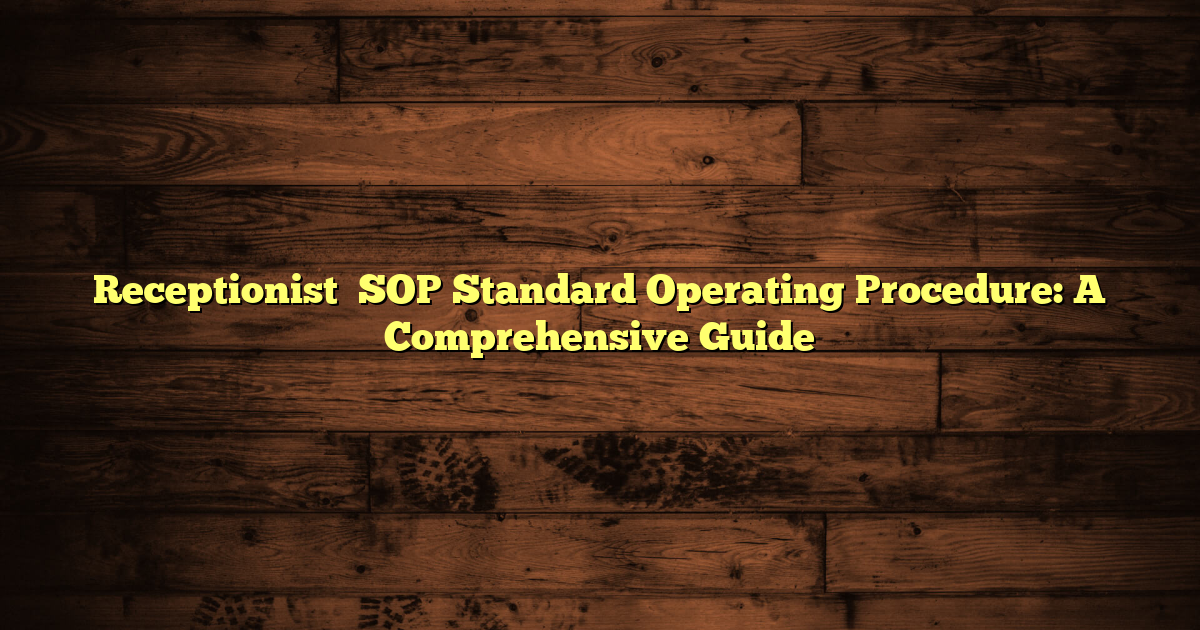Receptionist SOP Standard Operating Procedure: A Comprehensive Guide
Table of Contents:
- Purpose or Scope of Receptionist SOP
- Key Components of Receptionist SOP
- Benefits Of Implementing A Receptionist SOP
- Conclusion
- FAQ
Receptionist SOP Standard Operating Procedure: A Comprehensive Guide
Have you ever considered just how vital the role of a receptionist is? Receptionists are often the first encounter guests, clients, or customers have with a business. A Standard Operating Procedure (SOP) for receptionists is a detailed document that outlines the step-by-step processes needed to effectively manage front desk operations. It’s particularly important in environments where delivering service is the main business, such as hotels, medical practices, or corporations.
Purpose plus Scope of Receptionist SOP
The main goal of a receptionist SOP is to give clear, defined responsibilities to the front desk staff. This is so they provide great customer care consistently. This ensures that each guest receives a friendly greeting, correct information, as well as timely help throughout their experience with the company.
Its scope generally includes these areas:
- Greeting guests
- Verifying reservations
- Managing check-in and check-out procedures (especially in hospitality)
- Handling questions over the phone or in person
- Processing payments (if needed)
- Documenting interactions carefully
- Coordinating with other departments
By creating a framework, these tasks become standardized:
- Receptionists have a clear understanding of their work.
- Service quality remains consistent, regardless of staff changes.
- Errors are reduced through adherence to specific steps.
- Accountability is established – failure to follow procedure may lead to disciplinary action.
Key Components of Receptionist SOP
1. Greeting Guests/Visitors
Receptionists often are the first people visitors meet – therefore, their behavior sets the scene for the rest of their experience. The SOP should direct receptionists to welcome people warmly using eye contact together with a real smile as soon as they come in.
If you know about returning guests, use their name to make the interaction more personable.
2. Verification Process
When someone arrives, particularly at hotels, the receptionist should confirm reservation details using management software like Property Management Systems (PMS). This includes checking guest names against booking details, including dates of stay as well as payment methods.
In a medical office or a business setting, you might need to verify appointment times or visitor passes instead.
3. Check-In Procedures
For hotels:
- Prepare registration cards/forms for guests to sign.
- Explain hotel policies, as well as services available during their stay.
- Ask for identification such as passports or IDs to verify identity.
- Record all needed data into digital systems, maintaining data accuracy.
Outside of the hospitality business, this might mean having visitors sign a log or giving them temporary badges.
4. Handling Luggage (Hospitality Context)
Receptionist SOPs also often have processes for managing luggage:
- Offer help politely when a guest arrives.
- Tag luggage clearly with the guest’s name together with room number to prevent any confusion.
- Check the condition of luggage prior to moving it and tell the guest if there’s damage.
- Keep daily records that track all stored items until departure.
Such focus provides operational smoothness, while also building guest trust.
5. Managing Guest Queries & Requests
Receptionists must reply quickly to questions, no matter if these are asked in person or over the phone:
- Answer calls within three rings using greetings, which identify your name together with your company or department.
- Collect details quickly before transferring calls.
- Provide correct details regarding services available.
- Forward tricky issues following company guidelines.
Doing so makes sure that all questions receive an answer. This helps boost customer satisfaction.
6. Documentation & Record Keeping
Precise documentation is another important part of a good receptionist SOP:
- Record check-in/out times accurately.
- Log payment transactions safely.
- Note down special requests from guests.
- File complaints/incidents methodically for follow-up.
Correct documentation allows you to monitor performance while you support audits where needed.
Benefits Of Implementing A Receptionist SOP
Well-documented steps help both employees including the business itself:
Consistency – Doing the same each time across all shifts reduces confusion between employees, leading to reliable service always.
Efficiency – Having precise instructions shortens training periods for new workers, because expectations have been explained clearly from the start.
Customer Satisfaction – Quick, polite replies along with a respectful approach leave good impressions. This raises the likelihood of repeat business including recommendations.
Risk Mitigation – Proper verification can stop dishonest actions, thorough record keeping can assist with resolving conflicts if needed.
Employee Accountability – Defined ways of working clarify responsibility, making it easier for managers to spot performance gaps quickly.
Conclusion
A complete receptionist Standard Operating Procedure acts as a vital tool. This helps front desk workers through important everyday tasks. These range from greeting guests to exact check-in steps to thorough record keeping after the interaction. All of this is designed to give seamless experiences reliably across different fields but especially in places such as hotels.
By carefully following these documented steps such as greetings – reservation confirmations – documentation requirements – luggage handling (where it applies); answering calls – emphasizing precision – also, showing friendliness, businesses can keep standards up.
This ensures both operations run great. It also improves how happy guests are.
FAQ
What exactly is a receptionist SOP?
A receptionist SOP is a detailed guide that outlines the processes including duties for managing a front desk, making sure things are done consistently and professionally.
Why is an SOP important for receptionists?
An SOP is important because it establishes clear guidelines for receptionists. It helps them to deliver service which is consistent, decrease errors, next to improves customer satisfaction.
What areas should a receptionist SOP cover?
The SOP should cover things like greeting guests, checking reservations, managing check-ins and check-outs, handling questions, processing payments, keeping records, also, coordinating with other departments.
Who benefits from a receptionist SOP?
The staff, the company, in addition to customers all gain from using an SOP. It boosts service consistency, improves efficiency, grows customer happiness, manages risks, together with improves employee accountability.
Resources & References:





